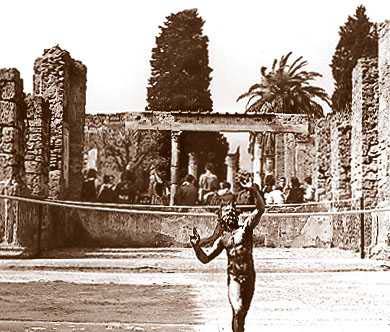|
|

| (ins. 12, no.2-5) It is a dwelling of remarkable proportions,
harmonious and well-balanced in its design and elegantly decorated in
its various rooms. It represents the classical type of Roman house. It
undoubtedly belonged to one of the most prominent local figures, that is
the nephew of Sulla who dealt with the political organization of the
city. Its original structure dates back to the Samnite period, that is
to the 5th century B.C.; its present-day condition should be dated to
the transformations of the 2nd century B.C. The Tuscan atrium belongs to
the first period and has a stone floor. The second atrium is, on the
other hand, of the Hellenistic type and has four Corinthian columns. Its
reputation and its name are linked essentially to the small bronze of
the "Dancing Faun" found here, a small masterpiece of ancient statuary.
Not to be forgotten, however, is the mosaic housed in the Archaeological
Museum in Naples showing the "Battle of Alexander", exceptional in terms
of its size - it does in fact measure 3.5 m x 6 m - but also in its
expressive power: it shows a throng of soldiers, lances and horses
captured at the moment when Alexander, by now the victor and proud of
his troops, is just about to inflict the decisive blow on the routed
enemy. This mosaic paved the tablinium. Among the rooms particularly worthy of mention are the two peristyles: the first has an Ionic colonnade partly decorated with stuccos and with a magnificent exedra, which is also decorated with mosaics, the subject being "flora and fauna from the Nile region". The second, the larger of the two, has a Doric colonnade disposed around the garden. |